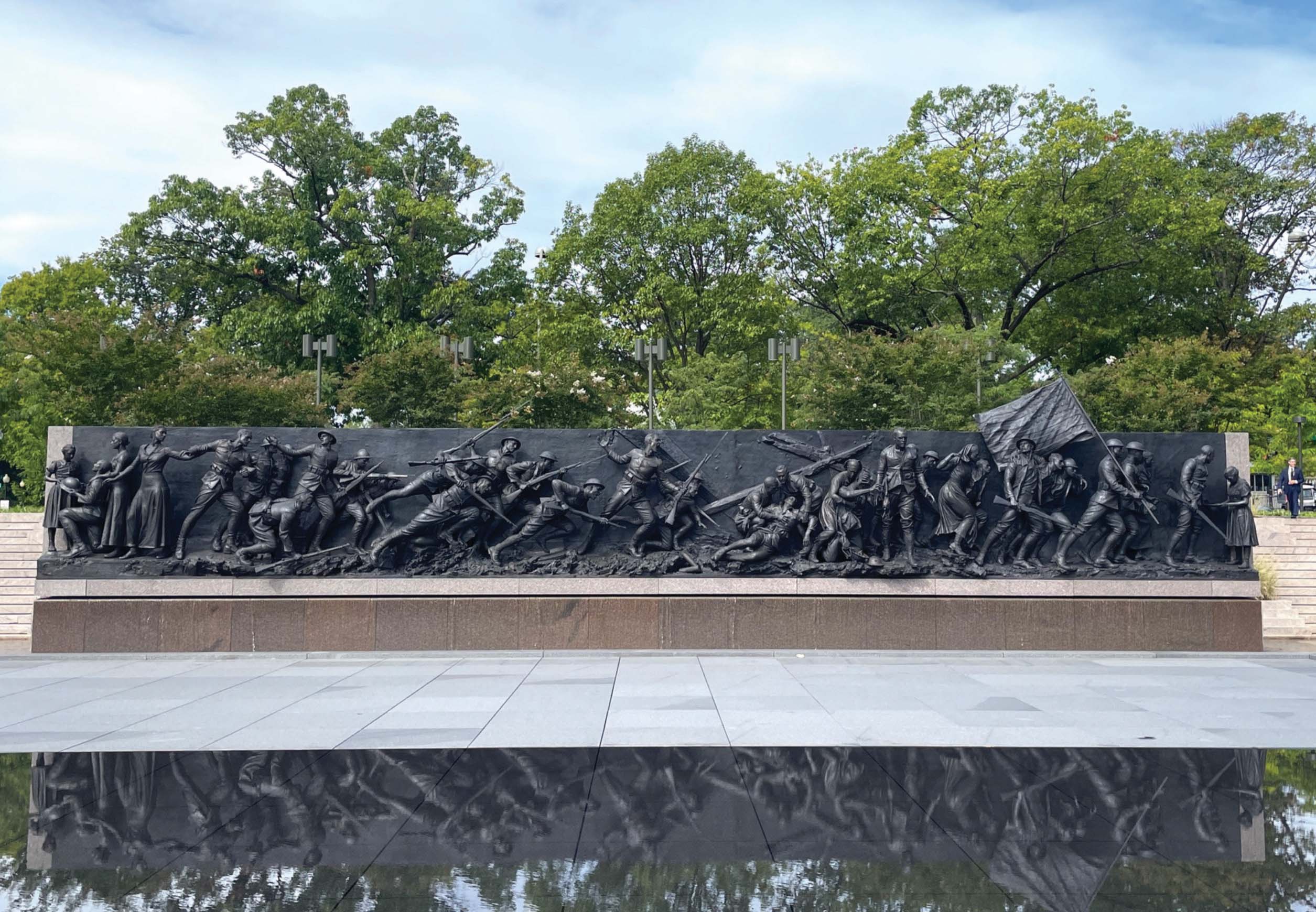
31 Oct A SOLDIER’S JOURNEY
“Happiness,” sculptor Sabin Howard says, “is fleeting. Purpose gets you out of bed every day.”
Howard’s all-consuming purpose for the last decade has been a 58-foot bronze sculpture featuring 38 larger-than-life-size figures moving through a cinematic homage to the men and women of World War I.
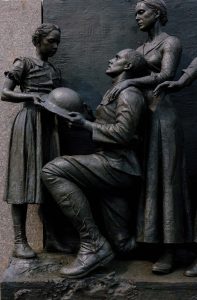
The sculpture’s story begins with a young girl handing a helmet to her father, who is preparing to leave for the war. Photo courtesy of Sabin Howard
In September 2024, his sculpture, A Soldier’s Journey was installed on the World War I Memorial grounds designed by architect Joe Weishaar. Located in Pershing Park, a block from the National Mall in Washington, D.C., the memorial — with its fountain and reflecting pool, terraced landscape, and solemn, understated design — created the perfect stage for Howard’s explosive sculpture.

Washington, D.C.’s Pershing Park was named for John J. Pershing, whose World War I leadership propelled him to General of the Armies — a rank he shares only with George Washington. Howard’s monument, A Soldier’s Journey, completes the National World War I Memorial. Photo: Alan Karchmer/OTTO
You might be wondering why, amid all the memorials in our nation’s capital, there wasn’t one already dedicated to World War I. Call it an oversight. There was a memorial, but technically, it was dedicated to the people from Washington, D.C., who fought in WWI. To rectify the situation, Congress appointed the WWI Memorial Committee in 2015, a century after the Great War, to kickstart the project.
Weishaar was living in Chicago when he saw the call put out by the memorial committee. At the time, he was working as an apprentice in an architecture firm, wasn’t licensed yet, and had never even been to Washington, D.C. Still, what did he have to lose? He pulled together a concept, sent it off, and then completely forgot about the whole thing until he received a phone call from the committee telling him he was one of five finalists out of more than 350 applicants and asking him to come to Washington the next day.
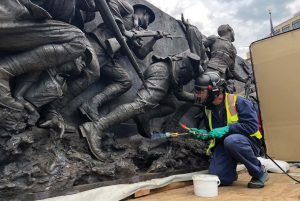
Howard applied the patina on location after the sculpture was placed along a stone wall in Pershing Park.
Howard had also applied for the memorial but with a different architect, and his team was knocked out in an earlier round. Prophetically, he told his wife he didn’t think that was the end of the project for him; the New York-based sculptor had a good feeling about this one.

The monument, dramatically illuminated at night, accentuates the chaos and struggle of war.
To win the bid, Weishaar had to find an artist who could create the massive 324-foot-long bas-relief he had proposed for the memorial. He turned to the National Sculpture Society, and from their list of recommended monumental sculptors, he began researching each artist. One name on the list jumped out. Weishaar had seen the drawings Howard submitted to the WWI Memorial Committee. “I just cold-called him,” Weishaar recalls. “I started telling him about the project, and he stopped me and said, ‘I’m in.’ He had been working on drawings for months, so he’d already put a lot of time into it.”
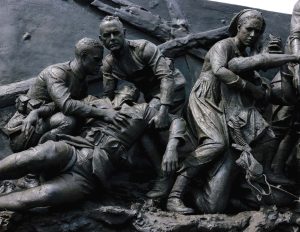
A middle scene of A Soldier’s Journey depicts the physical and mental wounds of the fighters. American women who served at home and on the front are represented in this scene. And, as the turbulent left-to-right narrative pauses, the hero stops and looks directly at the viewer, inviting contemplation of the costs of war. Photo courtesy of Sabin Howard
Howard, like Weishaar, had never created a memorial or artwork on that scale. In hindsight, it might have been their combined brilliant naivete that compelled the team to bring to life one of the most reverential memorials in a city filled with some of the greatest tributes to humankind. Working as a team, they designed and pitched a 90-foot-long high-relief sculpture, which was ultimately refined to 58 feet. Once the final drawings were approved by the committee, Howard began the laborious process of bringing his vision to life.
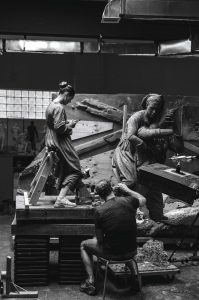
To create the monument, Howard sculpted models from life who dressed in period clothing and committed to posing for months. Photo courtesy of Sabin Howard
Those familiar with Washington, D.C., may recall that Pershing Park was once an ice skating rink. In the warm months, it was a pond, but in winter, an underground network of refrigeration piping turned the water into ice. After two new ice rinks opened in the city — one near the Smithsonian and another by the National Christmas Tree on the Ellipse near the White House — the Pershing Park rink and its surrounding landscape went to seed; it was simply too expensive to maintain. When the WWI Centennial Commission launched their project, they inadvertently turned a spotlight on the blighted land and brought preservationists out in force. Weishaar describes the nearly 3-acre Pershing Park plot of land he was handed as “needing a lot of love.”
“It was run down from a decade of deferred maintenance,” he says. “The park was so overgrown you couldn’t see into the site. And there was a lot of illicit activity happening there.”
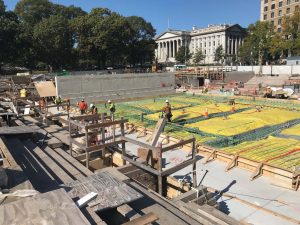
Architect Joe Weishaar and his crew repurposed an old ice skating rink in the park, transforming it into a reflecting pool and fountain. Photo courtesy of Joseph Weishaar
When it came to turning the park into a memorial, there were two sticking points of public dissent: the pond and the artistic style of the sculpture. To Weishaar’s credit, he welcomed public opinion. “We invited everyone to participate,” he says. “If someone had something to say, we were willing to listen. Everyone was very involved. Everybody listened. It wasn’t a one-person process.”
Preservationists demanded the artificial body of water be saved, which was costly but something Weishaar could convert into a fountain and reflecting pool. In fact, he was able to preserve much of the original landscape and hardscape by rearranging elements and reusing nearly all the stone that was on the site. “Actually, 90 percent of the stone used for the new memorial,” he says, “is original to the location.”
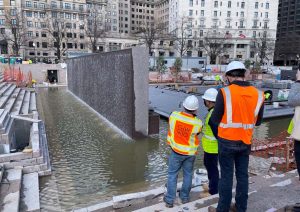
Weishaar and his crew test the reflecting pool; A Soldier’s Journey was formally dedicated in September 2024. Photo courtesy of Joseph Weishaar
The demands for a more contemporary sculpture rankled Howard, though, and he remained firm in his vision to create a realistic depiction of life at the turn of the 20th century. “The sculpture needed to be about the WWI era,” Weishaar says. “The landscape needed to be modernist to frame the memorial. I think we found a good balance.”
The thought of working on a monumental bronze sculpture for nearly a decade may sound grueling, but in reality, it only took that long thanks to the help of modern technology. After Howard’s sculpture was approved on paper, he flew to New Zealand to work with Wētā Workshop, the Academy Award-winning studio behind the special effects for such movies as “The Hobbit.” Wētā brought Howard’s design to life in a three-dimensional model, which Howard sent to the members of the Centennial Committee. Upon viewing it, Howard says, “They started crying. They were in shock.”
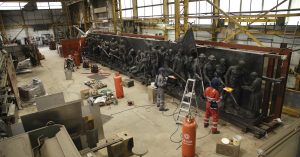
An aerial view shows Howard at work with the artists at Pangolin Editions, a foundry in the U.K. Photo courtesy of Sabin Howard
It would be great to say that everything was smooth sailing after that, but there were a number of hurdles left to clear. When all the issues were addressed, and Howard got the approval to move forward, he worked to find models who could enact the dramatic tableau he wanted to bring to life.
Here again, technology played a role. Howard and his crew of models flew to the U.K. to a photogrammetry studio where the models were photographed in three dimensions. Full-sized armatures were created from those images and measurements, and shipped to Howard’s studio in the U.S. For the next several years, he brought models in to pose while he applied clay and carved in details that imbued the sculpture with emotional impact.

An inscription on the backside of the memorial quotes former President Woodrow Wilson. Photo courtesy of Joseph Weishaar
As physically demanding as sculpting can be, creating a memorial adds additional emotional weight to the labor. Though Howard had read and heard stories of the devastation of WWI, the deeper meaning of his work didn’t fully manifest until he was about halfway through the sculpting process. At that point, word of the memorial had spread to veterans of foreign wars who began to come by the studio to see this sculpture. Naturally, these men began sharing their stories. Looking back, Howard recognizes that the process and those conversations changed him.
“My philosophy is to give back to others and leave the planet in a better place than it was when I was born,” he says. “But I was not that person when I came into this project. I had to learn it. And I learned that lesson very deeply from the military service people who came to pose for me.”
Whether his models had wartime experience or not, most commented on the intensity of the work. “There’s an energy that permeates the room,” Howard says of those long days in the studio. “This is a very spiritual way of seeing the world. There’s energy in everything; it’s what binds us together. Sculpting is about communicating in a universal language.”
Howard’s sculpture was cast in bronze in the U.K. by Pangolin Editions. At this point, Weishaar had completed the memorial site; all he needed was A Soldier’s Journey. Once Howard’s sculpture arrived back on U.S. soil, it was transported to its final home in Pershing Park. Gwen Pier, executive director of the National Sculpture Society, the organization that helped connect Weishaar and Howard, attended the lighting ceremony. “It is a truly moving memorial,” she says. “It speaks to the viewer in ways so many monuments fail to. Sabin’s work is a gift to our country.”






No Comments